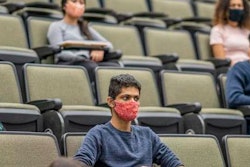Data gathered prior to the impact of COVID-19 shows there was a decrease in postsecondary enrollment in spring 2020 but the pace of decline slowed compared to the previous four years, says a report from the National Student Clearinghouse Research Center.
Overall postsecondary enrollment in spring 2020 decreased 0.5%, or by 83,803 students, from spring 2019, according to the report, Current Term Enrollment Estimates Spring 2020. National spring enrollment decreased 1.7%, in 2019, 1.3% in 2018, 1.5% in 2017 and 1.3% in 2016. The numbers include online students.
“This is the smallest rate of decrease that we’ve seen in years,” said Dr. Doug Shapiro, executive director of the National Student Clearinghouse Research Center. “It suggests that higher education, just before the pandemic, was nearing a new equilibrium after years of enrollment decline.”
 Dr. Doug Shapiro
Dr. Doug ShapiroStill, Shapiro said the report should be viewed as a pre-shutdown baseline that does not reflect any effects of the COVID-19 pandemic on enrollments.
The Current Term Enrollment Estimates Report series is typically published every December and May. This year, though, the National Student Clearinghouse Research Center will issue a special enrollment report in late June that will reflect the impact of COVID-19. Shapiro said it will show students who may have dropped out mid-semester, but also those who may have re-enrolled or changed their enrollment intensity (full-time vs part-time) in response to the disruptions on campuses and in the economy.
“Having a baseline of enrolled students is critical to any future analysis of the impact of the pandemic,” said Shapiro. “This will enable us to identify changes in student enrollment behaviors over the coming months and show how they may differ for specific student populations and specific types of institutions.”
The June report will likely assist colleges and universities in helping plan for fall 2020.
“I think institutions have often used the data to help identify opportunities for enrollment growth, but the great level of fear and unknowns surrounding the pandemic suggest that the first question people will be looking to answer now will be, how can we avoid losses,” said Shapiro.
The current report includes data by age, type of enrollment, gender, major and state.
California, Pennsylvania, New York, Ohio and Missouri showed the largest enrollment decreases, while Arizona, Utah, New Hampshire, North Carolina and Kentucky showed the largest increases. Shapiro noted that state and regional economies as well as policy environments affect enrollment numbers.
The largest spring enrollment decrease was seen in public two-year institutions, at 2.3%, and in private for-profit four-year institutions, at 1.9%. The decline slowed at the latter, which decreased 19.7% in 2019.
The data shows a 1.9% overall decrease in part-time student enrollment and a 0.4% increase in full-time student enrollment. Some notable increases are shown among students under 18, who grew 6.9%, or by 46,737 students, across all sectors. The report attributes this rise to dual enrollments, which usually involves high school students taking courses at community colleges, which grew an unprecedented 6.9% (46,737 students) over the previous year. At public two-year institutions, the number of students under 18 rose 8.7%, shows the report.
“This has been a growth trend for years as students and policymakers seek responses to the challenges of college affordability and long times to degree. Dual enrollment appears to address both of those concerns,” said Shapiro.
Just over a third of all students are older than age 24, but the average age of undergraduates has been falling, according to National Student Clearinghouse Research Center data, said Shapiro.
“We hope that this information will help draw attention to the need for education programs that enable all students to better balance the employment, family and other pressures they face today,” he said.
The report also shared data on undergraduate enrollment by major at four-year institutions. Liberal arts and general studies saw a 5.2% decrease in enrollment. Computer and information sciences and support services saw a 4.7% increase; transportation and materials moving saw a 5.6% increase; and foreign languages, literatures and linguistics posted a decrease of 4.6%.
At two-year institutions, there were increases in mechanic and repair technologies/technicians (4.8%); computer and information sciences and support services (3%); and construction trades (7.4%).
When the next report is released in late June, it will quantify the impact of COVID-19.
“We hope it will be used to direct assistance to the students and schools that are most impacted by the pandemic and most in need of support,” said Shapiro.


















